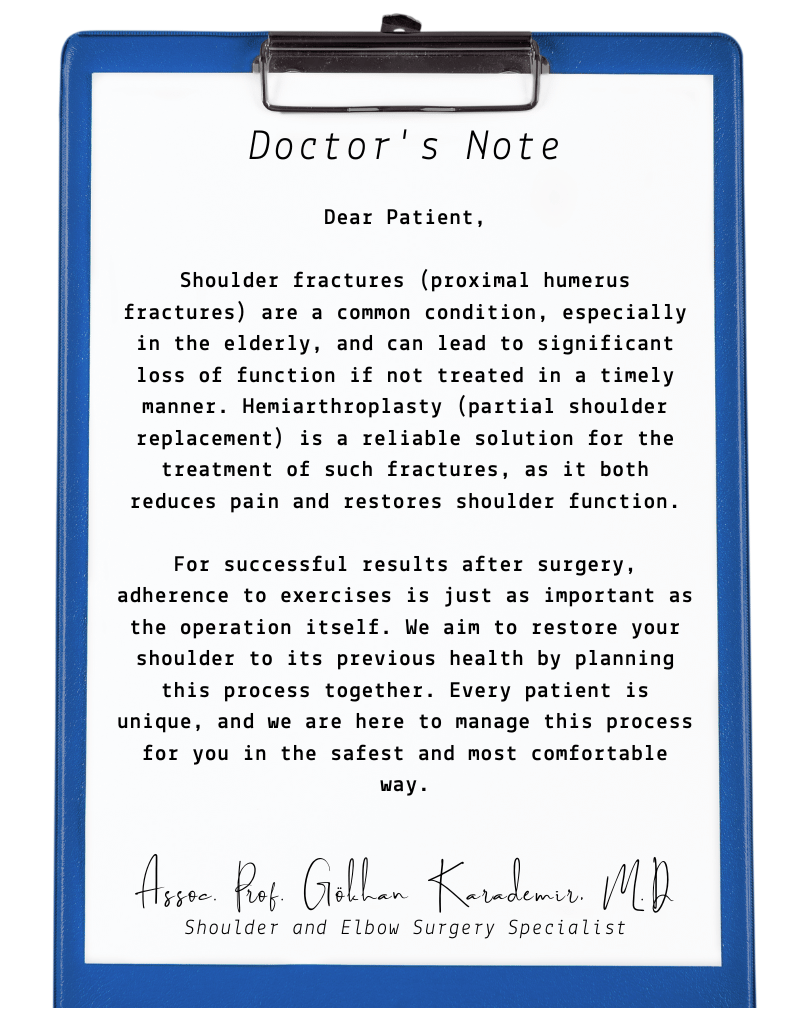Shoulder fractures, especially in elderly individuals, occur when the head of the shoulder bone (humeral head) breaks as a result of a fall. In younger patients, they are typically caused by high-energy trauma. When the fracture results in the shattering of the head portion that forms the shoulder joint, the joint alignment (congruence) is disrupted, and functional recovery may not be possible without surgical intervention.
While some fractures can be repaired with plates and screws, these fixation methods are not sufficient in cases that are severely fragmented (comminuted), displaced, or where bone quality is poor (osteoporotic). In such situations, a surgical procedure called hemiarthroplasty is performed.

Hemiarthroplasty is the replacement of only the damaged part of the shoulder joint—specifically, the humeral head—with an artificial prosthesis.
In this procedure, the joint surface on the shoulder blade (scapula) side—known as the socket (glenoid)—is preserved. Only the head of the upper arm bone (humerus) is replaced with a metal prosthesis. This is why the procedure is called a “partial shoulder replacement.” The healthy parts of the bone are maintained, and joint mobility is restored.
Hemiarthroplasty is an effective treatment method, especially for patients who have intact rotator cuff muscles but an irreparable fracture of the humeral head. Correctly positioning the prosthesis, in terms of humeral head height and orientation, is critically important. After successful surgery, shoulder pain is significantly reduced, and shoulder movement is gradually regained.
With proper patient selection, an experienced surgical approach, and timely initiation of exercises, it is possible to achieve a functional and pain-free shoulder with this method.

Surgery Duration: Approximately 90–120 minutes
Type of Anesthesia: A combination of general anesthesia and a nerve block (regional anesthesia)
Surgical Method: Open surgery (via the deltopectoral approach)
First day: 4–6 (2–3 if a nerve block is used)
First week: 3–4
After 2 weeks: 1–2
A hospital stay of 1–3 days is generally recommended.
First 4–6 weeks: Protected with an arm sling
Starting week 2: Passive motion exercises begin
After week 5: Active motion and strengthening begin
Month 3: Return to daily life Months 4–6: Full use in functional activities
First dressing change: Day 2
Wound check: Week 1
Suture removal (if needed): Day 10
Yes. Pain is significantly reduced because the broken and damaged structures in the joint are removed and replaced with the prosthesis.
With early exercises, the shoulder's range of motion is largely regained. However, some limitations may remain due to advanced age or associated muscle damage.
With proper patient selection and appropriate surgery, partial shoulder replacements can remain functional for 15–20 years.
Prosthetic loosening over time is rare. However, if it does occur, it can be corrected with a revision surgery.
A regular exercise program of 2–3 months is generally recommended. Adherence to this program (physical therapy) directly affects the success of the surgery.